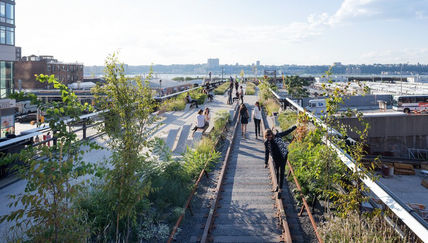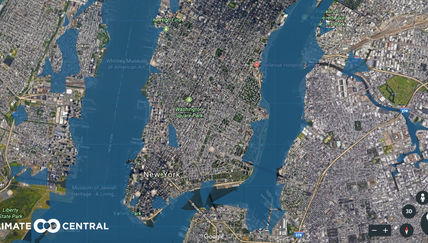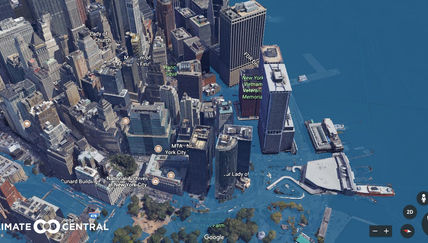High Line/Water Line
What is land subsidence, and how would it impact New York City?
Land subsidence is the gradual sinking of land as time passes. The northeastern United States is at a high risk for subsidence. This, coupled with the acceleration of climate change, puts larger and larger portions of New York City at risk for submersion in the not-so-distant future (Kaye par. 3-7).
How is New York City handling currently handling climate change?
New York City is combatting climate change in a variety of ways. Urban forests, such as Central Park itself, mitigate carbon in the atmosphere. New building will be built to greener standards, and the city government is switching to renewable energy. The city is suing major oil companies for their roles in perpetuating climate change. The city is also going to expand composting sites and organic waste collection (“5 Ways” par. 15-25).
What are green roofs and green walls?
Green roofs are the modification of existing roofs in order to support the growing of plants on them. They represent a movement across the world, but especially in Europe, to reclaim existing infrastructure for environmental purposes. Green walls are allowing and supporting the growth of vegetation on walls, giving many of the same benefits as green roofs. It is estimated that if 10 billion dollars is invested by the federal government in converting 48.5 billion square feet, or just 1% of existing roof space in communities of over 50,000 people, 190,000 jobs would be created (“About Green Roofs” par. 5-12).
How is the wildlife on the High Line organized?
The wildlife on the High Line is organized into 16 separate garden zones. Each is curated to best fit the micro-environment created by the city—some areas may receive more sunlight or precipitation, and the plants are chosen to fit these constraints. The gardens may also demonstrate a distinct method or ideology in planting, such as the central Chelsea Grasslands that display Piet Oudolf’s “matrix planting” style (“Garden Zones” par. 1-17).
How New York City changed over time?
During the Ice Age, around 20,000 years ago, the city was covered in a sheet of ice one mile thick. The boulders left by the Ice Age glaciers are still visible in Central Park. Prior to the 1500s, the Lenape tribe inhabited the land, surviving mostly off of hunting, fishing, and trade. The Dutch permanently settled Manhattan in 1624. Peter Minuit bought the land from the Lenape for the equivalent of around $1,000 in today’s money (Garfield, par. 4-11).
How else is infrastructure being reused in New York City?
The Brooklyn Navy Yards, Pier 40, and the Myrtle Avenue Station are other prominent examples of the city’s creativity in the reuse of older infrastructure as a means to solve modern problems. The Brooklyn Navy Yards now house hundreds of businesses and thousands of employees, generating over 2 billion dollars in revenue each year. The Pier 40 is a former marine terminal that has been transformed into a sports facility primarily used by youth and high school teams. The Myrtle Avenue subway station has been home to a 300 ft. art piece resembling a Victorian optical toy to resemble film (Brooks par. 7-22).
Based on projections, what will New York City look like in 2100?
Based on the worst projections, worldwide sea levels may be 12 feet higher in the year 2100 than they are now. These projections show water encroaching from the Hudson River. Battery Park is almost completely submerged, and the streets of the Financial District are almost completely flooded. Because the city is a series of islands, its future is uniquely linked with climate change (Robinson par. 14-15).
Does the High Line help combat climate change?
The High Line is an example of the type of forward-thinking that will help combat climate change. Although the actual benefits reaped from the High Line may not be substantial in the grand scheme of climate change, the park has inspired other cities around the nation to creatively repurpose existing infrastructure in environmentally sound ways. Thus, the spark it is creating may help combat climate change worldwide (Hiskes par. 1-8).
Works Cited
“5 Ways NYC Is Tackling Climate Change.” Climate Reality, The Climate Reality Project,
https://www.climaterealityproject.org/blog/5-ways-nyc-tackling-climate-change.
“About Green Roofs.” GreenRoof.Org, Green Roofs for Healthy Cities,
https://greenroofs.org/about-green-roofs.
Brooks, Galin. Reusing and Repurposing New York City’s Infrastructure.
https://wagner.nyu.edu/files/faculty/publications/Working_Paper_Brooks_2010.pdf.
“Garden Zones.” The High Line, https://www.thehighline.org/gardens/garden-zones/.
Garfield, Leanna. “Amazing Images of New York City before It Was a City.” Business Insider,
Business Insider, 13 Dec. 2016, https://www.businessinsider.com/images-of-new-york-city-before-it-was-a-city-2016-12#this-woodcut-of-southern-manhattan-is-from-1651-when-it-was-still-named-new-amsterdam-7.
Hiskes, Jonathan. “Does New York City's High Line Park Matter in the Fight against Climate
Change?” Grist, Grist, 17 July 2010, https://grist.org/article/2010-07-16-does-new-york-citys-high-line-park-matter-in-the-fight-against-c/.
Kaye, Leon. “New York City Is Sinking, and No One Knows What to Do.” Reporting on the
Triple Bottom Line & Sustainable Business News, 12 Sept. 2016, https://www.triplepundit.com/story/2016/new-york-city-sinking-and-no-one-knows-what-do/22891.
Robinson, Melia. “Disturbing before-and-after Images Show What Major US Cities Could Look
like in the Year 2100.” Business Insider, Business Insider, 22 Apr. 2018,
https://www.businessinsider.com/before-and-after-photos-of-us-cities-in-the-year-2100-2017-6#the-financial-district-encompasses-the-offices-of-many-major-financial-institutions-including-the-new-york-stock-exchange-and-the-federal-reserve-bank-of-new-york-10.






